1966 A Villi, Good Year?

It seems to me that there was a last ditch approach to beat the onslaught of Sammy Miller and the New Bultaco "Two Stroke" trials bike that was now dominating the World Trials Motorcycle scene.
British Manufacturers were throwing everything at the Challenge.
Little did they Know that their efforts would be in vane?
Well the supplier of their power plant would send them a Memo, saying that they were going to withdraw the Engine unit that they were supplying.
Who? "Villiers" Who else? Were pulling the plug on engine supply.
Absolute Disaster, again it turned the Motorcycle industry into total disbelief and despair...
And into a What-Do-We-Do-Now situation....
From Dennis Poore 1967...
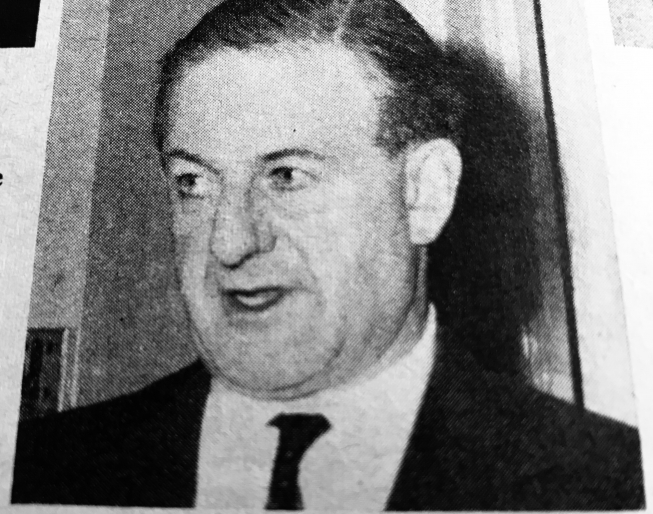
The Late Dennis Poore...The then new CEO of Norton-Villiers...
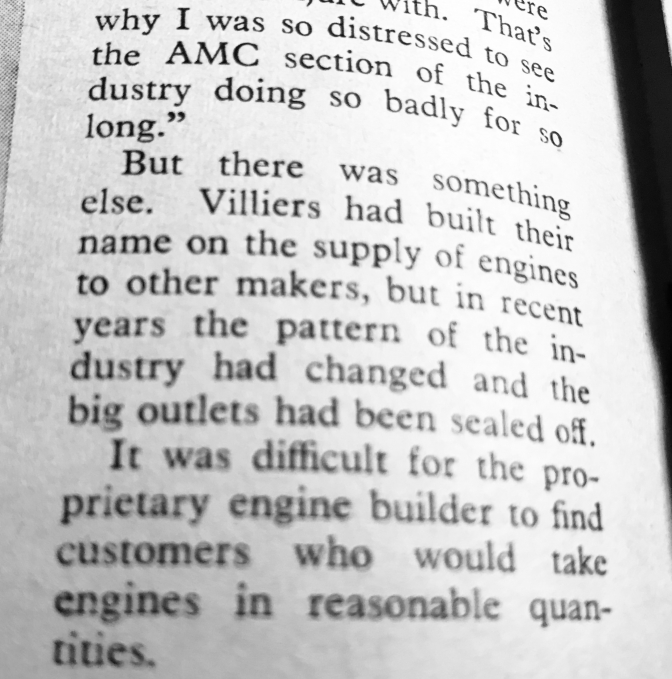
An Explination?...
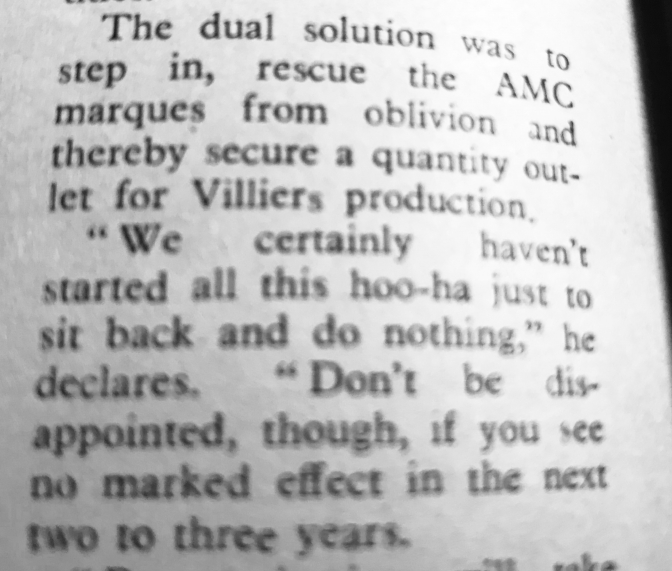
Well I see.......
Here are a few of the Manufactures Trials Models that you well may never have heard of... Because of the Plug Pulling...
The DMW Highlander
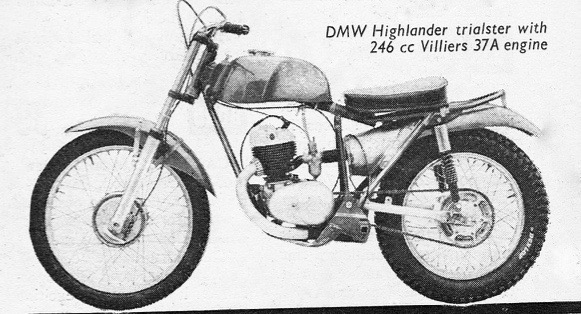
The DMW Highlander.
The frame of this machine was said to be made by Cotton too, Forks were Metal-Profile, which DMW had the patent for as designers.
They also held the patent for the swinging arm rear suspension, that is still used today on nearly every bike produced.
And a lot more patented suspension parts.
More history on DMW later.
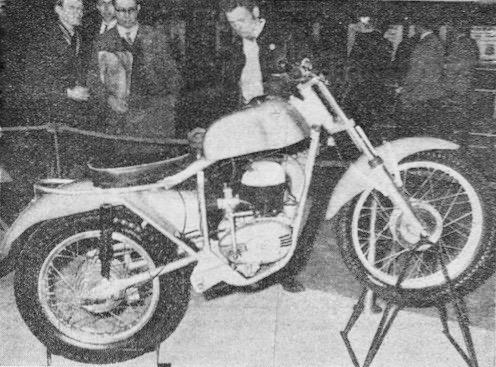
So DMW Dawson Motor Works...
Started by speedway rider and first class engineer and designer Leslie "Smokey" Dawson First company name was Dawson Motor Works.. in a small garage and pub yard, DMW started to first make hydraulic front fork kits to be fitted in place of the girder forks that were still the norm in 1940 on most bikes Leslie then devised a swinging arm kit that could be grafted onto most rigid bikes, and also patented the ideas… A man of ideas that was not good at raising capital to forward the plans ... along came Harold Nock an ex HRD worker and later director of Diamond Motorcycles (not the later Diamond trials bikes) and founder of the Metal Profiles Ltd...company, he bought into the DMW company in the mid forties and eventually moved production to his factory in Sedgley, West Midlands after the war, as production of the fork and swinging arm kits grew. DMW now stood for (Dawson Motorcycles Wolverhampton) this is where production of the lightweight Villiers engined motorcycles began in 1951. And also the AMC France engined race bikes, when Villiers refused them the twin cylinder engine...
Leslie Dawson had now sold his shares in the company to Harold Nock as he could not raise the capital for his plans…(1948) and moved to Canada. To work…
First motorcycle show in 1952 had six bikes displayed on the stand. a couple were competition bikes.. DMW had started using square section tube for their frames in 1951, and they were a lot different to what most manufacturers brazed lug and tube frames were, as these were gas and ark welded.
New bike designer that had taken over from Leslie Dawson, Mike Riley who came from BSA in 1946 had put a bike together and won the under 200cc cup in the 1948 Scottish, and this was a start of the competition bikes at DMW.. early trials works riders were Geordie Forbes and JCL Bodenham… Arthur Frost and Ernie Smith had joined the company in the competition racing department…although DMW ran these competition teams fortune in results did not seem to come to the team, mainly through lack of funding for competition projects.
It was not until much later (seventies) when the company had been bought by Graham Beddall and Metal Profiles acountant Ivan Dyke after they had managed the company from 1971 when Harold Nock had retired to the Isle Of Man that they finaly took control in 1975...That New development rider Mike Parkes joined the team and the trials results came he was ACU Midlands Centre trials champion for two years 1976 and 1977 for DMW…Other riders of this late sixties and the seventies period who had good results on the trials DMW’s were the Price brothers mainly Malcolm but Bill also had some good rides on the machines.
It seems to me that the ideas at DMW were perhaps what contributed to their lack of success (or popularity) as the frame design was much different to most other motorcycle manufacturers of the time the use of the pressed steel rear section of the “P”type frames as they were known and the use of square section tube was way before its time, the same thinking eventually came with firstly the Ariel Leader(Arrow) frame and then the Japanese companies taking the concept to an all new level in the sixties. The good example is the DMW Mk10 trials bike.

Photo Giff Courtesy DMW motorcycles ...
In the words of Sammy Miller..."It's a good thing somebody else had to ride them"...

Photo Courtesy Offroad Archives ...
This is the plunger DMW Type SS trials of 1952.. in the Scottish trial...

Photo Courtesy Offroad Archives...
Bill Price aboard the Price brothers rigid DMW that they enjoyed riding so much in the sixties seventies eighties and even nineties...

Photo Courtesy Offroad Archives...
Keith Wells aboard the same Price machine in one of the Scottish Two Day Pre65 trials.

Photo Courtesy TM-C...
This is the DMW with Highlander type frame at the Sammy Miller Museum...
More DMW's Later...
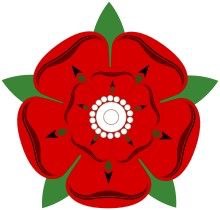
Kyffin Sapphire."Red Rose"
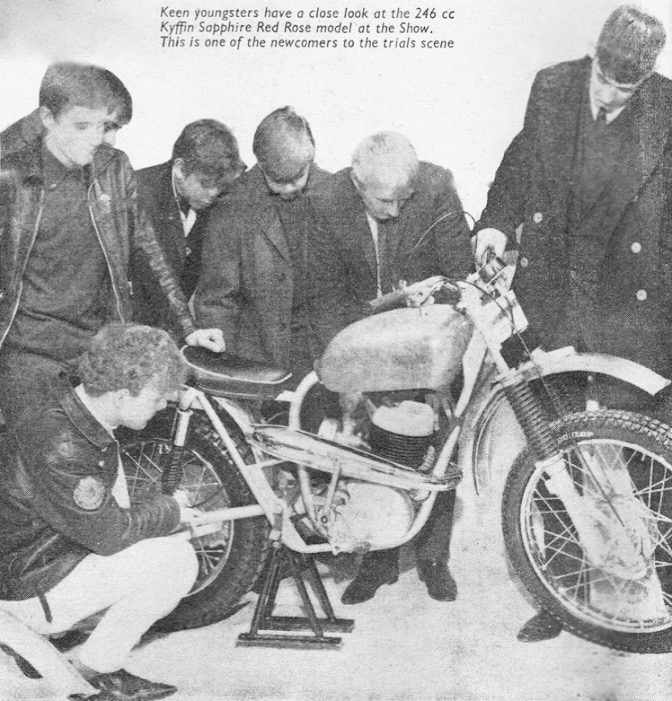
The Kyffin Sapphire "Red Rose" Trials Model.
Now how Many of these have you got in your Garage.
The late Roger Kyffin, of Stockport, Cheshire built trials and scrambles machines under the ‘Sapphire’ name powered by Triumph and Villiers engines, initially using modified DOT frames, and later those of entirely his own design. Powered by the Triumph 5TA twin-cylinder motor, Kyffin’s specials were light, fast and very successful Scramblers.
Engines were bought as sets of spare parts, (Triumph would not supply complete units) until Meriden twigged what Roger was doing and swiftly, put a stop to the practice, and Roger Kyffin was forced to look elsewhere, for a power plant.
He turned to Villiers, producing a particularly neat trials model powered by the 37A engine, but when the supply of these dried up, production stopped, as it did with the rest of the other manufacturers trials models using the Villiers 37A engine units.
Knowing that all "Two Wheeled" sport is linked,
Roger's son Andrew, Has run a very successful North West Mountain-bike Centre for years.
The specification for the "Red Rose" trials bike is as follows.
A superb handling machine designed by Trials Riders.
Lightweight frame and cycle parts, slimline glass-fibre petrol tank.
Smooth action telescopic forks with 6" movement.
Girling damper rear suspension pivoting on silentbloc bushes.
Adjustable Timkin taper roller bearings fitted to the steering head.
6" "Motoloy" full width hubs front and rear.
Dunlop "Trials Universal" tyres, and cable operated rear brake.
Polished Alloy Mudguards, 1/2"X 5/16" Renolds chain.
Smiths 80 mph spedo-meter, Slimline Primary Chain-case.
Villiers S25 Carburettor and air filter. Bulb horn.
Note: you can see that the prototype tank has been made longer and slimmer in the second picture.
But all prototype "British" Two strokes that came out of the woodwork at the time seemed to have bulbous GF fuel tanks, without any style.
But most were quickly changed to one with more style later when in production...
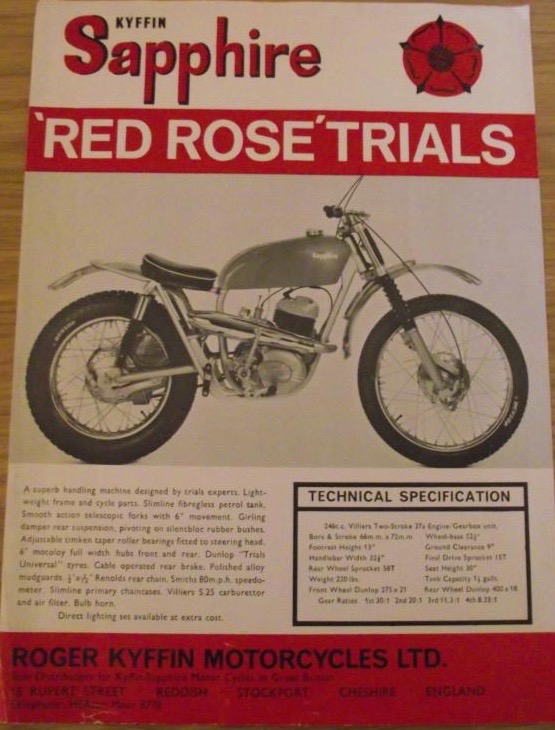 Photo Courtesy Simon Hatcliffe.
Photo Courtesy Simon Hatcliffe.
More later on this story. Thank's Simon.
The forks are said to be Betor the same has fitted to Bultaco at the time.
Thinking back this Machine could have been the nearest rival to the all conquering Bultaco of the time, if only the corporation behind the Villiers name had seen the light instead of totally ignoring the current market for these Villiers 37A engines. No matter what financial difficulties they foresaw, and then to be pig-ignorant and decide they knew best, and would build their own machine... No matter what. Just did not make sense.
Roger Kyffin could have been the "Guru" of British trials machines, instead of being shunned by the trade. How easy it is to now look back.
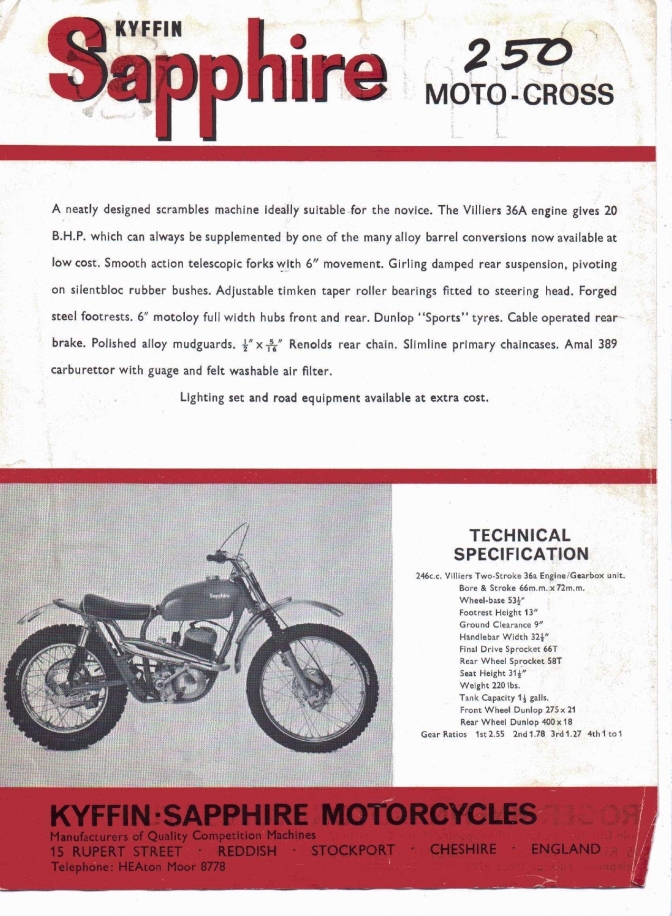 Photo Courtesy Simon Hatclffe.
Photo Courtesy Simon Hatclffe.
This is the 250 Scrambles version of the Sapphire, note it is named the Moto-Cross in 1966.
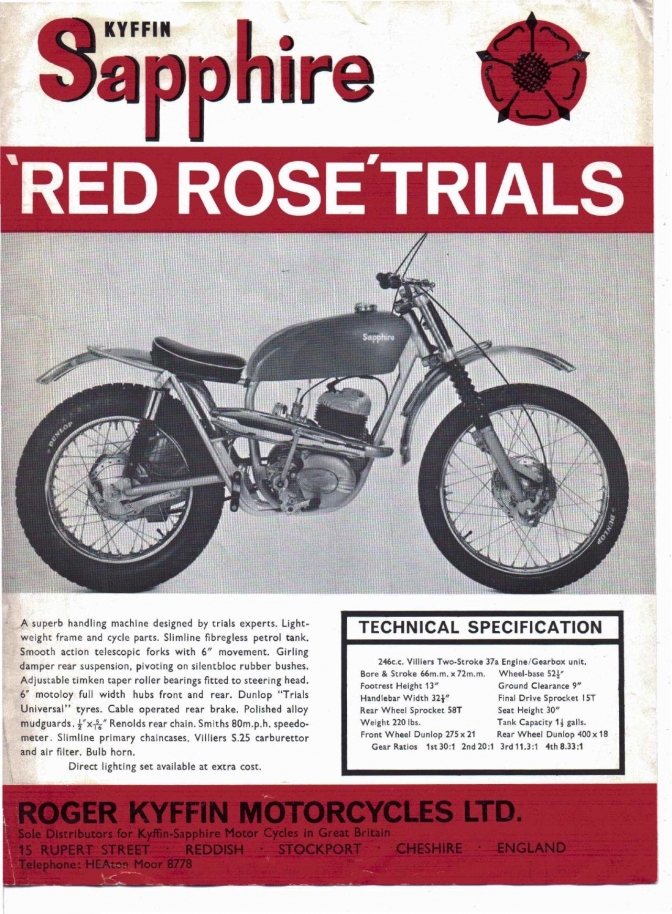 Here is a better scanned version of the above that Simon has kindly sent me to use.
Here is a better scanned version of the above that Simon has kindly sent me to use.
You can read most of this now on this version.
But I am leaving the above because this shows how these pages evolve, any pages that any of you think you can provide me with information to update, just send it me I will be most grateful.
I am doing this for you guy's as well as myself.
How many of you had heard about a Kyffin Sapphire? Until these pages.
I must thank Simon Hatcliffe again for coming up trumps with this vital information for the preservation of the history about this brand of long forgotten machine.
More later on this.
We move on to the Scorpion...
The Paul Wright "Scorpion".Own page, under Scorpion sports bikes.
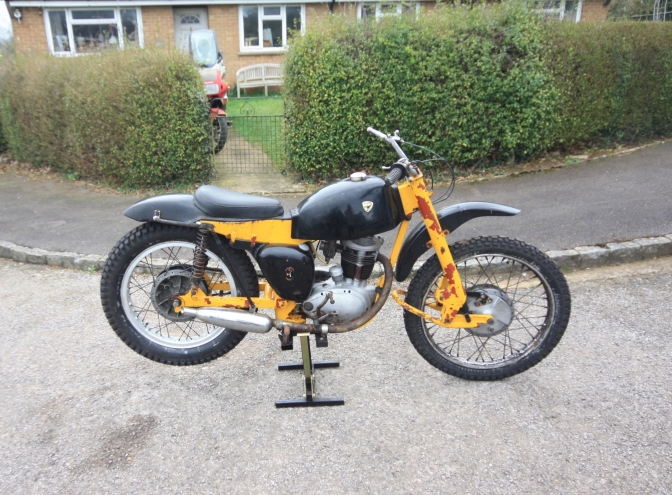
This has a one off BSA engine but most had Villiers power...
The Scorpion. That just still qualifies.
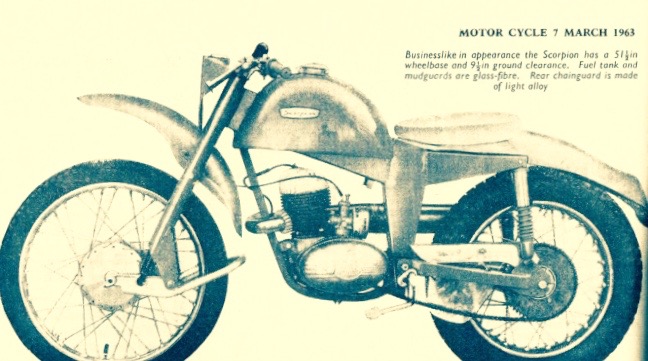
Scorpion now has it's own page...
More to come, the "Sprite" The "AJS".
The "Elstar" which we already have a page.
And CoTTon that was said to make some of the other makes frames...
We will delve further into this last ditch "British Two Stroke" trials.
industry, and we will be there on the DOT... Gollner be a long journey.
Better call the Butler, for another Scotch, although that Greeves me.
James and Francis are still in the frame, has is Norman, and the Sun has only just set...on a few, HJH quite a long time ago.. big family really...
And then there was the big "Exit" of mine that I never did get to finish and put into manufacture. And try and avoid the Firefly and the Cheetah.
Moving on.. and the culprit for the demise..
AJS 37A,T...
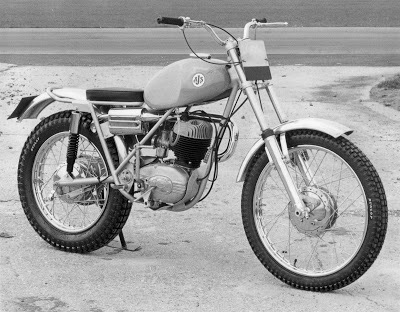
So this was the Machine that put an end to the rest of the two stroke Trials Machine production throughout the United Kingdom at a stroke? Manganese -Bronze Holdings the New owners of "Norton-Villiers", decided that they would build their own bikes, and the rest of the industry could go away and find their own power-plants to use, or pack up manufacture.
Could you believe how a management of a company the size of M-BH could make this decision?
It is still making me fume now writing this.
We now have a bit of an insite at the top of the page but wrong thinking in my mind still...why not just have kept supplying the lot? But we now know there was a shortage of getting the engine parts made and the work force to put them together...
Cotton were now receiving the only amount of "Starmaker" engines that were made.
The frame for the AJS was also said to be made by Cotton or more so through Cotton as they were allegedly made by a supplier based in Thruxton. Or were they? Same Cotton jig I think...
By March 1967 Fluff Brown had been enticed to leave his long time position at Cotton and move to Norton-Villiers in Wolverhampton.
Scrambles rider Andy Roberton had been signed by N-V to ride the new cobbled together scrambler, with "Starmaker" engine.
Peter Inchley had been poached from BSA Triumph, to develop the "Starmaker" engine, and in his spare time fitted a development "Starmaker" engine into a Bultaco TS race frame to help develop the road race engine, along with being now the man in charge of the complete AJS-Villiers sport bike research and development department.
Roberton soon got fed-up with NV, and started to use CZ's supplied by Dave Bickers.
Inchley went on to finish third in the Isle of Man TT 250 race in 1966 on-what was also a basically a cobbled up machine, but quick, and also had found the reliability needed...
But what an Image Norton Villiers were portraying.
Not really one of a listed PLC, more like a shoe-string small company.
The 37 AT trials used mainly the same parts as the bikes they were fronted to replace.
In that they used Metal Profile forks, and some of the so called Works bikes the Davis Brothers, Malcolm, and Tony used, sported Ceriani forks like the scrambler when they could get away with it... Inchley quickly made them refit the forks fitted when he spotted the others fitted..
"MotoLoy" brake hubs were used, Girling Shocks, and a Peco type exhaust...
The myth is that there are only 10 of these machines still in existence, but considering the amount that were stockpiled unsold, at Thruxton, there have got to be more frames somewhere?
Or were they just cut up?
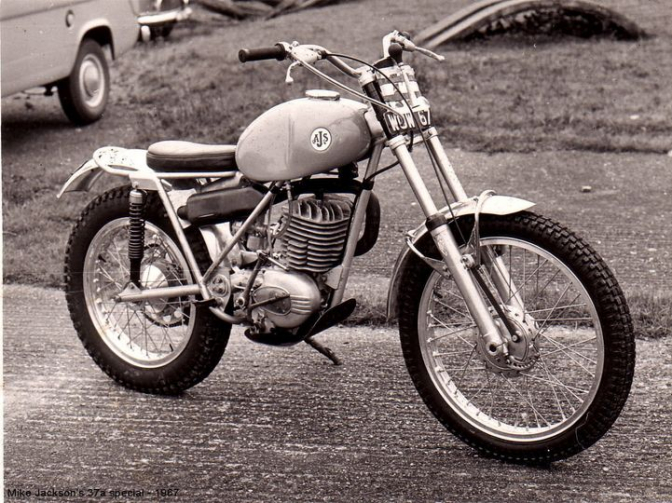
This is AJS's Marketing manager Mike Jackson's 37 AT, fitted with a Starmaker barrel, and what is said to be a one off cylinder head.
Also Note: the Bultaco rear and possibly front brake hub, or was it one of the scrambler hubs that were lighter.. ...
~~~~~~~
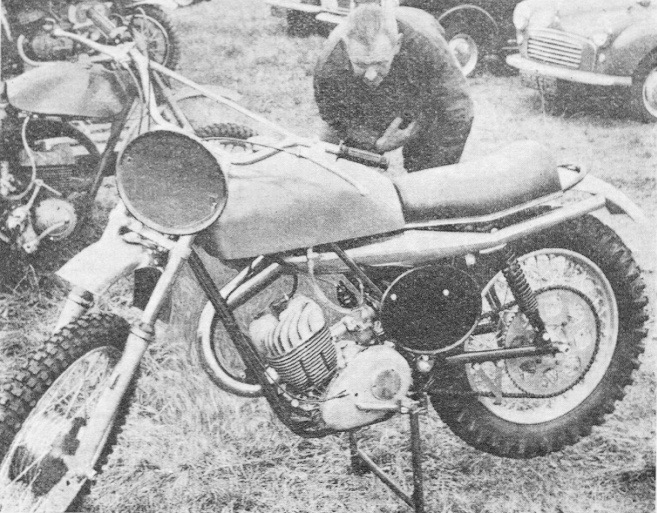
Here is the cobbled up Scrambles bike at Farleigh Castle in 1967,
Andy Roberton, rode it until the back brake anchor broke, and put it out.
Tank and seat are just temporary!
Manganese Bronze Holdings went the same-way as the nineteen sixties British Motorcycle industry, and were liquidated in 2012.
DMW bought some of the tooling and spares from the liquidated Norton Villiers in the early seventies, and carried on making 37A engines for a while, and looking after the National Health Service invalid carriage engines for the government contract.
Much later when DMW ceased production, the Villiers spares and the Metal Profile forks were sold to Competition Classics in Manchester. We know that Metal Profile forks were later sold to Greeves Motorcycles.
There has been a whisper that the Villiers 37A engine may again rise from the ashes. So watch this space.
I may even be able to get a Villiers 37A engine to finish my prototype
"Exit" Type 37 trials bike from the drawings done in 1967-8...
And AJS Motorcycles now own the AJS brand name and is run by "Fluff" Browns son Nick...
~~~~~~~
1966 CoTTon, Trials.
Probably CoTTon were favoured by Villiers at this time, more than any other British Motorcycle manufacturer. As I have said CoTTon were receiving most of the Starmaker engine production from Villiers.
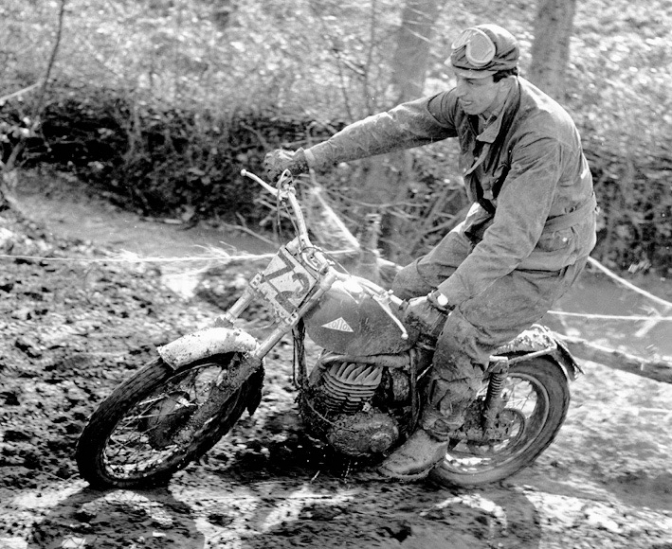
Photo Courtesy Offroad Archives.
Colin Dommett riding the works "Starmaker" Villiers engined bike ....
Note: that the registration is 1964...
And the first bike to probably wear the MP teli-forks..
~~~~~~
And I remember having to wait in 1967 a while for a couple of Kit Form trials models to arrive, as the production was said to be over stretched.
Eventually the two kits appeared for me to assemble at North Bar Garage in Banbury, after suffering the wroth of the father of the twin boys that were to be recipients of the two new machines.
They arrived with the steel fuel tanks, instead of the neater glass-fibre ones specified. That too was not taken lightly by the father of the two boys.
The frame on these bikes was a lot like the later frame to be produced for the AJS 37AT with the only difference as I can see being the method of rear chain adjustment.
The AJS was adjusted on the swinging arm front pivot, where as the CoTTon used the conventional sliders on the rear of the swinging fork.
And the AJS having the large top frame tube, But the dimensions were very much the same and may have been made on the same jig ?
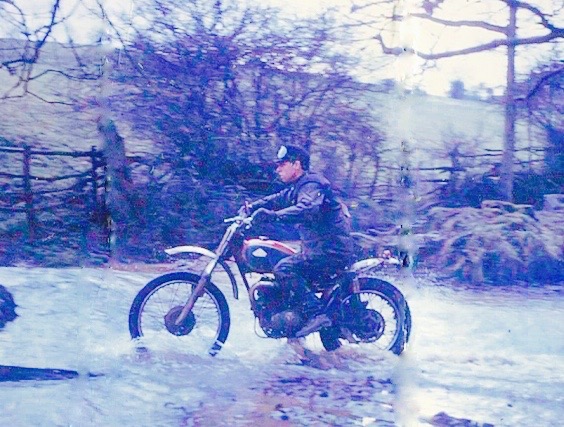
Photo Courtesy Stuart Bedford.
Reg Number NBW 1**F
Here is one of the two CoTTon's I put together from kit form, this is Mr Bedford on board riding through "Traitors-Ford near Sibford in North Oxfordshire.
You note that these two bikes were fitted with the New to CoTTon "Metal Profile" forks, it was about this time that "Tube Investments" were pulling the plug on "Norman Motorcycles", and had also now bought the Sun brand motorcycles that used Armstrong forks until it was closed... although the "Telstar" racers were still fitted with the Armstrong designed leading link forks, that were supplied to Cotton from Norman Motorcycles. And I bent a few of these and still received the spares for them, collecting them from a garage in the middle of Gloucester in the evening when I had finished work. So CoTTon must have had a load of the Armstrong forks stock-piled.
One thing about the Metal Profile forks supplied by DMW, now fitted to the CoTTon Trialsters, was that a Memo came with the Kit saying that the top of the fork stanchion needed to be pulled through the top yoke by an inch to make the bike steer.
Just a matter of using what was currently on the Market.
Colin Dommett being Works rider at the time, was probably the one that settled on this setting. The CoTTon frame was designed to use the Armstrong front Fork, so this is why the MP forks upset the steering geometry,
And is probably also why the AJS 37AT did not steer.
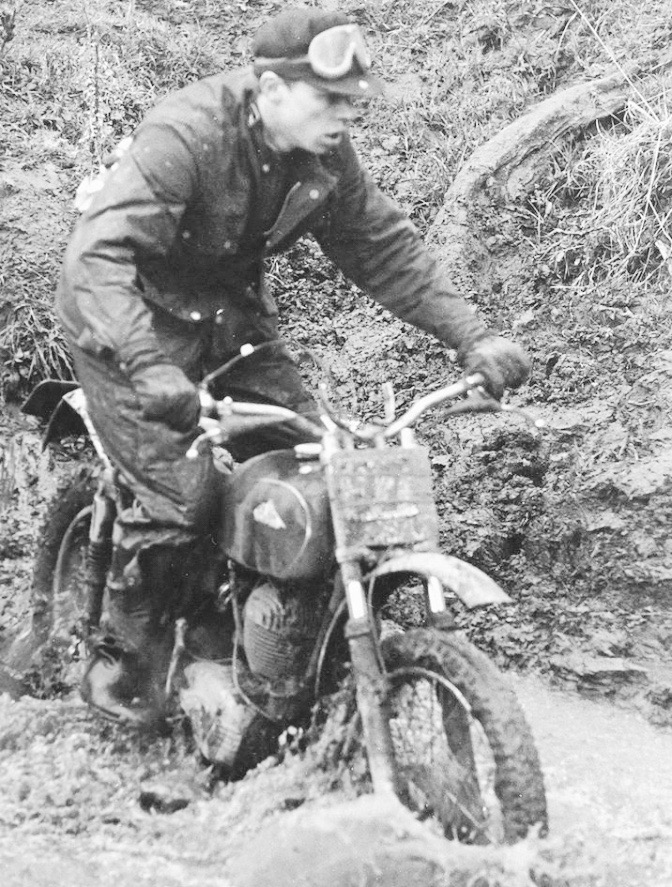
Photo Courtesy Stuart Bedford.
You can clearly see in this shot the 1 inch of stanchion above the top yoke.
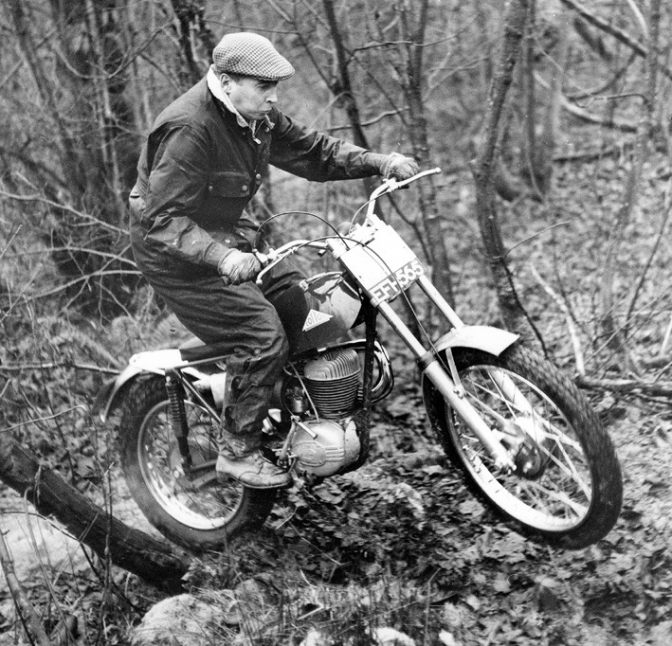 Photo Courtesy Deryk Wylde Offroad Archive again.
Photo Courtesy Deryk Wylde Offroad Archive again.
And here is an even better shot of the Green Framed, Red tanked bike, Pat Onions demo bike, being tested by the Late Max King.
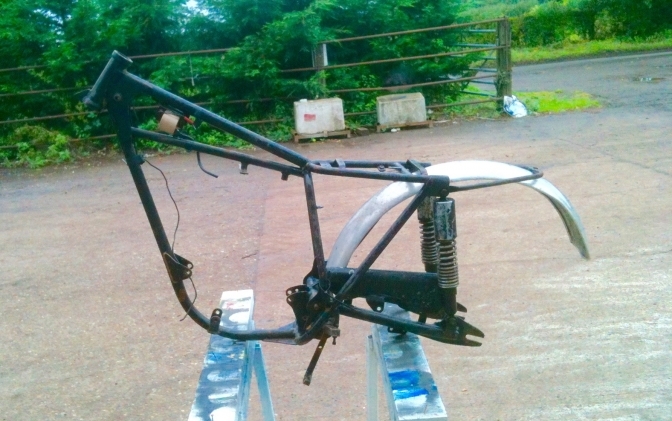
This is a 1967 frame that was the CoTTon green that I have found on the headstock.. Frame number T 61107 the six and seven are the year frame number 110...
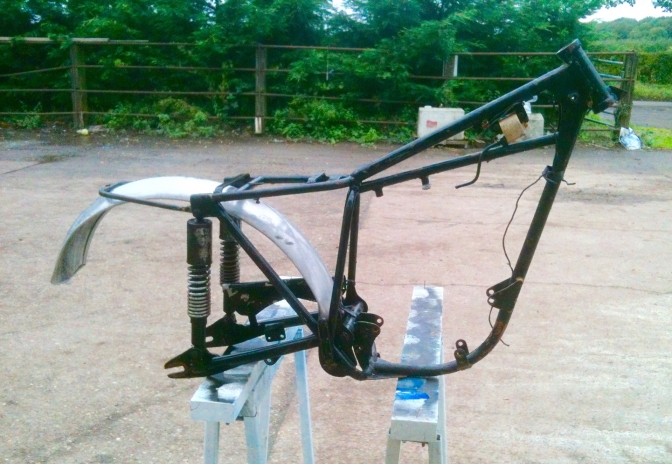
This is another "Back-Of-The-Shed" project...
But have now committed to get it done by 25/01/2020...
(Not now with Covid)...
What have I done..
Need a 37A gearbox pronto...
Watch this space...
Here you can clearly see where the inspiration for the "Sprite" frame came from with this shot that I took of the Cotton frame, and yes I will take a better one to replace this as I work on the bike.
Ths is a CoTTon Javalin built in the seventies just before CoTTon closed... one of only 23 built using the limited run of DMW produced engines, and although DMW had now bought the rights to the Villiers engines there were not many Villiers parts used in this engine... Alpha crank Maul piston and DMW head and barrel and I believe the gearbox was an Albion...
_______
Now just look at what CoTTon could have built in 2016, if they had stayed in the forgotten motorcycle market at the time.
Again Justyn Norek has the vision, brilliant.
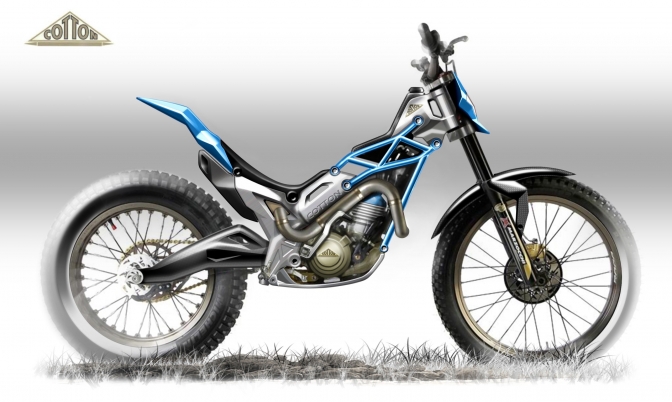 Copyright Justyn Norek...
Copyright Justyn Norek...
Gollner Whitlock Cheetah...

Cheetah Villiers. 1967-69...
The Inspiration of Bob Gollner a motorcycle dealer and trials rider from Denmead in Hampshire in the South of England, and tinsmith/coppersmith and Welder, Mick Whitlock, who had learnt his trade by being an apprentice in one of the shipyards on the South coast.
Mick became a very skilled motorcycle frame builder and bronze welder over a period of time...
Frames were made from Reynolds 531 tubing that had for a long time been used by both custom cycle and motorcycle frame makers as being the best there was available.
The Cheetah frame kits built by Mick were available from Bob Gollner Motorcycles from 1967 to 1969, fitted with the Villiers 37A trials engine, and some complete bikes were also built, these with REH forks and British Hub Co's Motoloy hubs...
The kits comprised of the frame swinging arm, a very neat black glass-fibre fuel tank, alloy mudguards and a neat little upholstered trials seat, with the taper roller head bearings fitted REH forks were the standard fitment. Villiers engines could be supplied as standard 37A's or fitted with Greeves barrels, until the introduction of the REH cylinders.
Gollner introduced the Robin Humphries front disk-brake assembly for the bikes also in 1968… along with the REH round alloy barrel and head, designed with the porting spicific for trials use with that midrange "Grunt"...
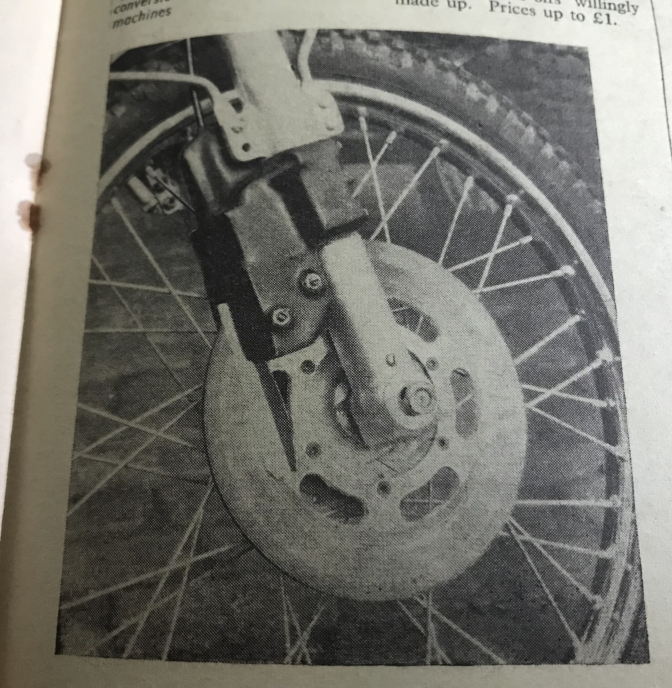
From 1968 Motor Cycle Mag
Production was short again because of the drying up of the Villiers engine supply and riders then jumping onto Bultaco’s.
I estimate less the 100 were built...
moving on to Sprite...
Frank Hipkin Sprite.
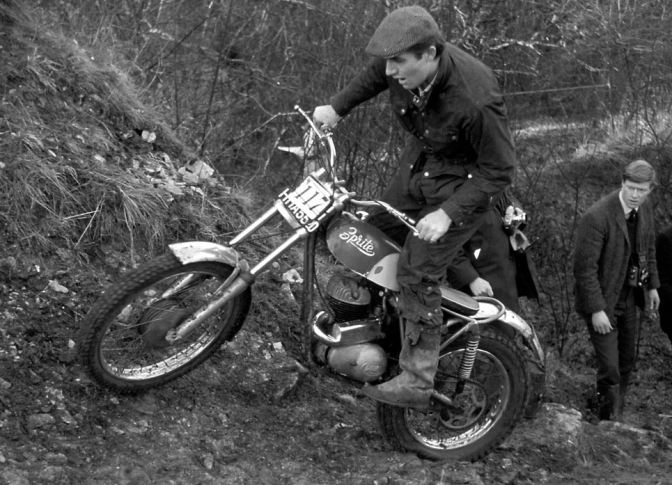 Photo Courtesy Deryk Wylde Offroad Archive.
Photo Courtesy Deryk Wylde Offroad Archive.
Dennis Jones "Jonah" on one of his flat out approaches to every section.
If any boy could test a Villiers 37a to destruction "Jonah could"
You can nearly hear the motor crying "enough"...
~~~~~~~
The story about the Sprite trial bikes will be linked to the Chris Leighfield- Dennis Jones Page,
But here is a Video that Frank put together before his sudden departing.
I was in contact with him at the time and he so pleased that someone had again taken interest in the 'Mark'.
Piecing together what information I have found, and talking to people with knowledge of the Midlands Trials scene at the time, along with the help from the Hipkin family.
This is my account of the time scale of the Villiers powered Sprites.
1963. Development started to produce a Sprite trials bike. Starting point, a CoTTon frame that had the front frame loop replaced with twin small diameter tubes, to gain ground clearance. Easy with a plumbers pipe bender? Don't forget half of the team was a plumber. Then looking at building the frame for production, ( being a plumber) it would make sense to bend the top tubes running through to the seat rails in just two lengths! The rest still looked very much like a Cotton. registration number 830RHA...
(This development is totally as I see it and the way I would have gone about the task)!
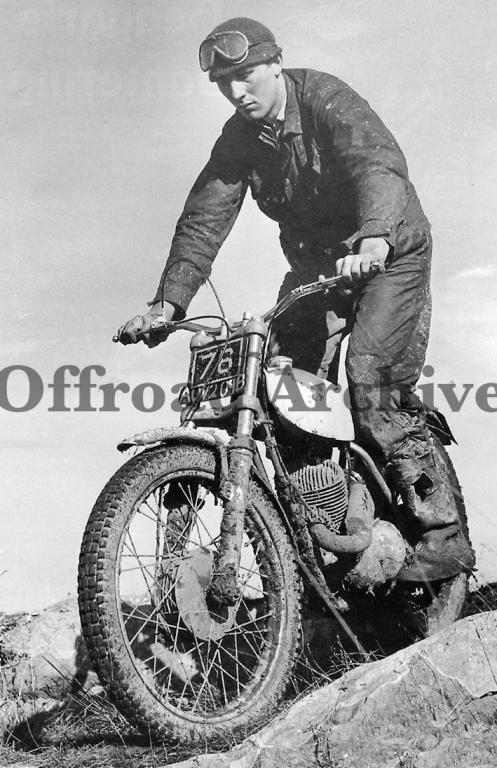 Photo Courtesy Offroad Archive, with permission.
Photo Courtesy Offroad Archive, with permission.
1964(B) registered bike above...
1964. First production frames are produced; We now know that AMC forks were used on the first batch of bikes. Also that the Glass-fibre fuel tanks were very bulbous and to be honest slightly ugly? British Racing Green in colour. This shot of the Mk1(A) frame that was basically the next one on from the Cotton with the two small section engine carrying tubes, and now with the two combined top and seat tubes, the tank on this bike also seems to be the Cotton one, Note: the Birmingham registered Registration number OV and "B" 1964.
Was It Sprite or Cotton in the little green book? But the Frame makes it the 'Sprite"...the first modified bike with the first Sprite tank badges, the 1963 bike was registered as a Cotton "Jonah" told me...(830 RHA).
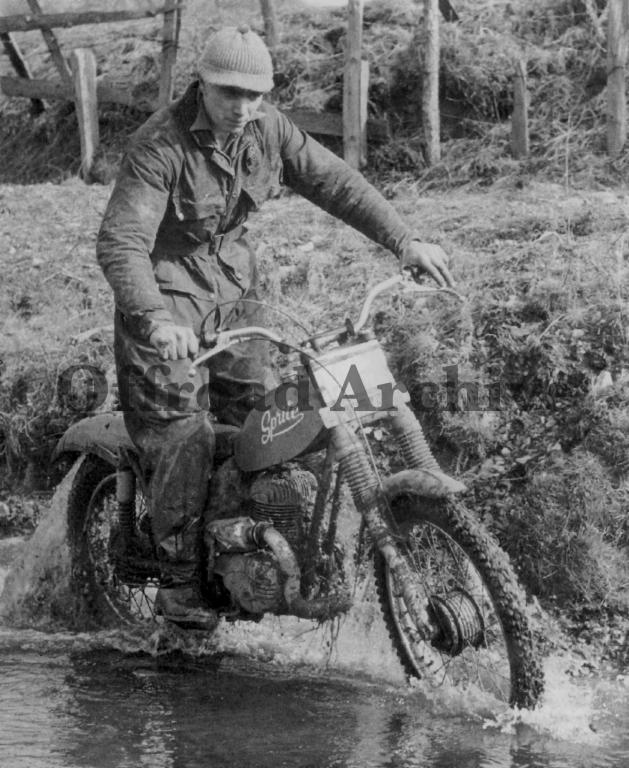 Courtesy Offroad Archive again with Permission.
Courtesy Offroad Archive again with Permission.
1965. More development had refined some areas in the design, ground clearance was slightly higher. During this period the new Monza Starmaker engined bike was being developed. This appeared in the press in October. The bike had 10 inches ground clearance but still with a seat height of only 29 inches. The forks were of leading link type, with longer Girling units, and producing a travel movement of 7 inches. Nylon pivot bushes were fitted to these and to the swinging arm. Price in kit form £184, while the Standard trials, price was still kept to £149 (32A engine) only £4 more than the year before. Jonah rode in the Scottish for the first time on a Sprite.
This shot above is Arthur Dovey on his Sprite that he bought from Frank as a frame and fitted an engine that he had from the Rickman Brothers forks are AMC.
Arthur built the bike in late 1964 and it was registered for the road in early 1965.
Arthur was also sponsored by Frank on the machine.
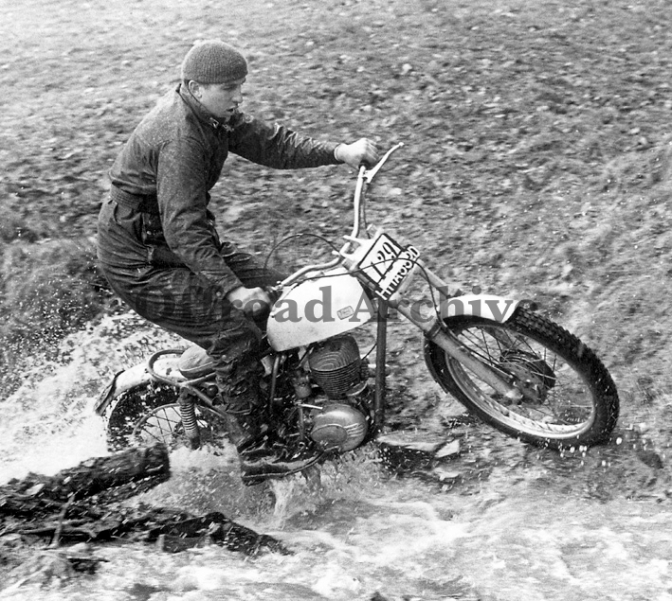
Photo Courtesy Deryk Wylde Offroad Archive.
1966. This is the year that the Sprite kits were pushed to the fore, and sales coming from the novice rider, as well has the professional? Some well known names were now riding Sprite machines, as well as the two development riders. I have a photo of Sam Cooper on a Sprite fitted with Bultaco forks and front wheel. The results started to come during 1966 and Sprite was now a leading trials winner as well. A team was entered in the Victory trial and Jonah won the under twenty-one Cup and finished second overall.
Team members were "Jonah", Sam Cooper, and Chris Leighfield.
A young Mick Wilkinson, was also given a Sprite to ride.
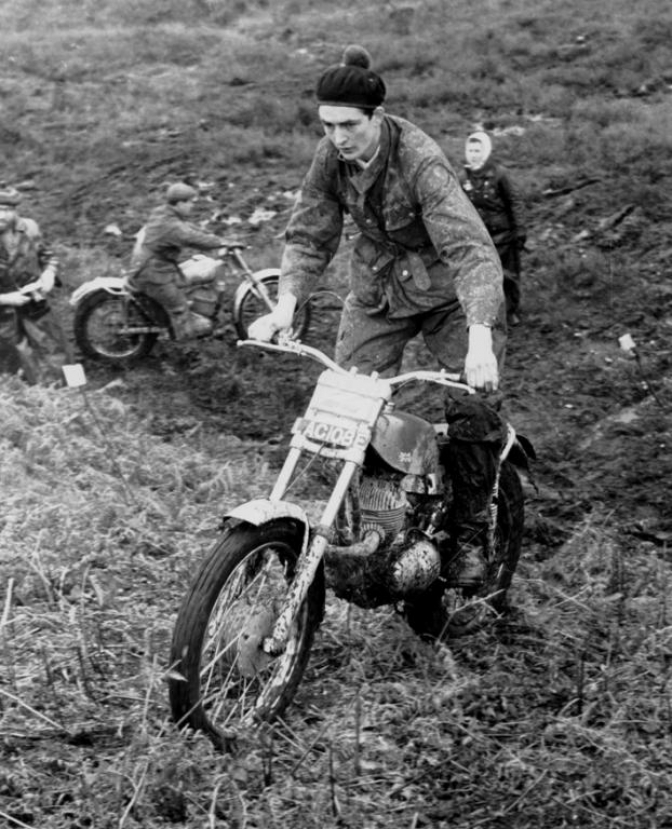 Photo courtesy Offroad Archive again.
Photo courtesy Offroad Archive again.
1967. As far as I can see this is the year when the frame was modified again, and this is the years that the two seat down tubes were lost. So "Sprite's" without these tubes are not Pre-65 but of 1967 origin.
Here a determined Chris Leighfield sets is sights on the ends card ahead, with the patriotic British Racing Green tank and British Union Jack flag. He also swapped to a Blue tank at times.
OK... that is my rambling with the history as I see it with what information I have.
25/11/2020...
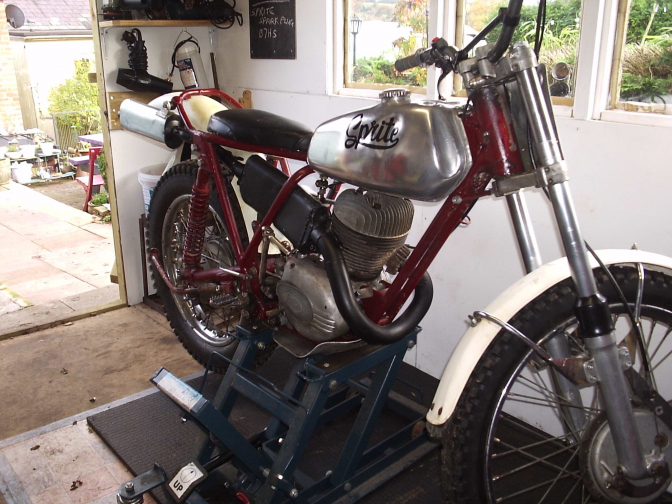
This is Adrian Scrivens's Very original Sprite I think this is a typical 1966 machine?
We would like to know if I am right as Adrian needs the year of manufacture to road register the machine.
~~~~~~~
More about Sprite later. and there is more on the Chris Leighfield "Sprite" to Vibsa's and More". Page.
So lets go to the Highham Firefly
~~~~~~~
"Higham Firefly".
20/07/2018.update...
The Firefly made and developed by my late brother-in-law Phillip Jones in the 60s . Phillip later lost his life while leading a Mountain rescue team in Scotland.
John Lockwood.
~~~~~~~
These are the only Pictures I can find for this Machine, said to be built by
Phil Jones in Lowestoft Suffolk. From 1965 to 1970. and one ridden successfully by John Lee for a time.
They were said to be really neat and lightweight and steered really well for the time.
But Another case of having no engine available to fit when Villiers Pulled the plug.
This is Martin's bike has you know
Martin bought the frame kit when he was 17 in 1967.
And fitted a B40 lump into the machine before later fitting a BSA B25 engine in 1970.
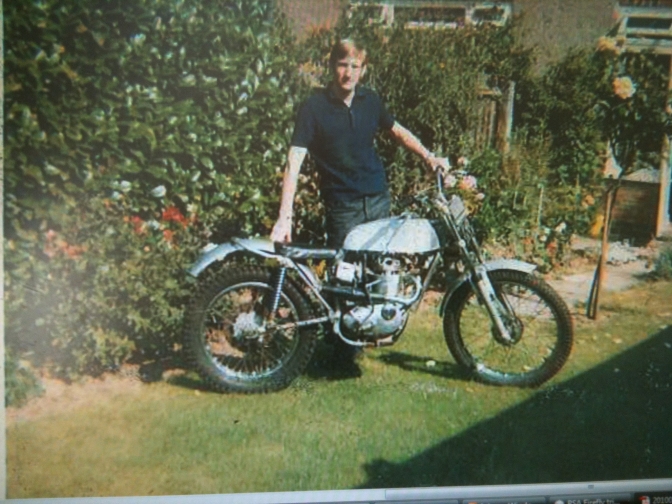
Photo Courtesy Martin DeVaise,
I am hoping I can get the story about the "Higham Firefly" from John Lee, fingers crossed.
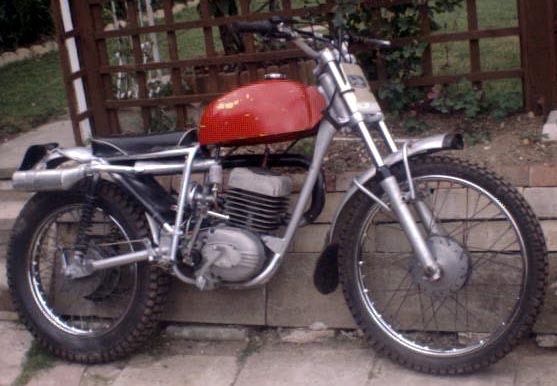
Photo Courtesy Andrew Ives.
Here is a 250 Villiers Engined version of the bike, I believe the "Kits" were sold mainly for the Villiers 37A...
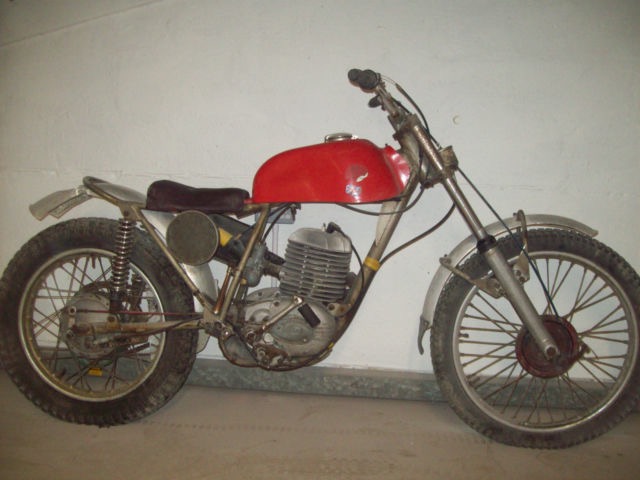
Here is a Greeves top ended Villiers "Firefly" framed bike.
I must say the steering seems very long on this machine that was said to be built in 1967.
Maybe it is just an optical allusion or the rear shocks are to short. Or taking another look the fork yokes have to much offset, they need to replaced with parallel yokes.
This bike was also registered in Northamptonshire so could have been a frame "Kit" sold by
John Lee?
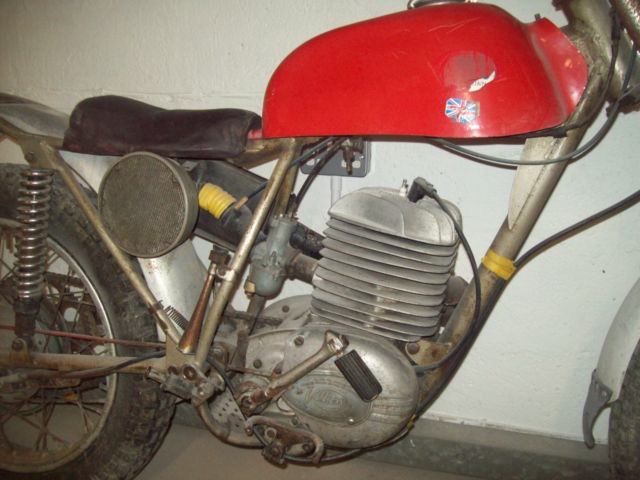
The frame kits were said to be nickel plated, and this frame looks like it was.
Also fitted to probably one of the first folding footrest, but only to necessitate the kick-start lever being used.
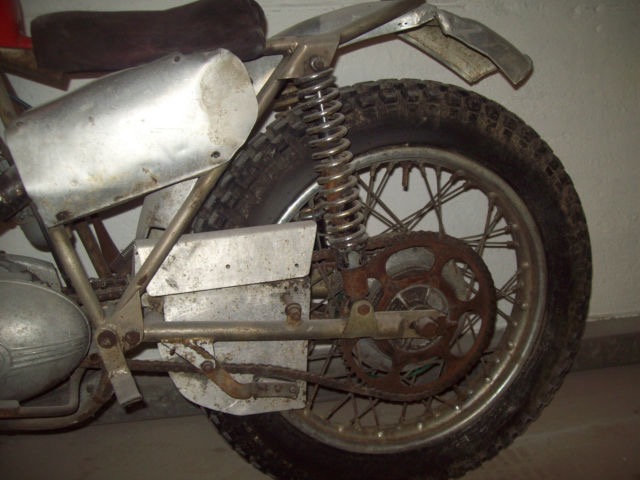
Here you can see a better layout of the frame, and I would think with the later added chain tensioner. Good engineering practice again with the swinging arm shock bottom mounts.
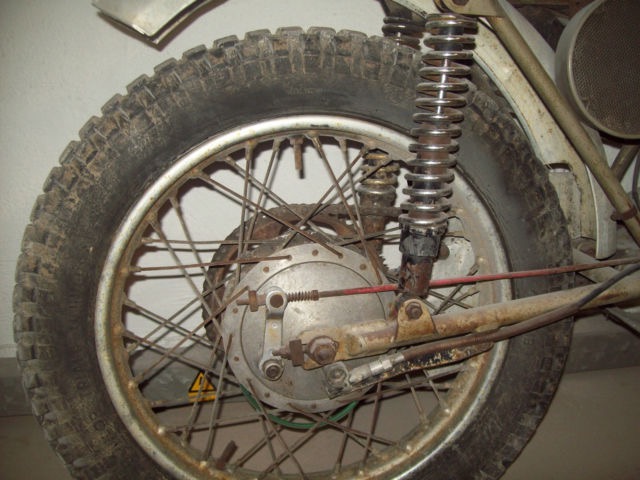
The frames looked to be well designed, if you look at the position of the lower suspension brackets... With light weight tubing the best position to bronze weld a bracket for vertical movement would be on the side walls of the tube. "Motoloy" Hubs again used, it is such a shame that this company went the same way as all the others in the late sixties.
DOT. Elstar, Butler, Norman, ETC Have their own pages.
Another rider that used to have a "Higham Firefly", was the South Midland Centre rider Brian Daveraux. And has ridden it in recent years.
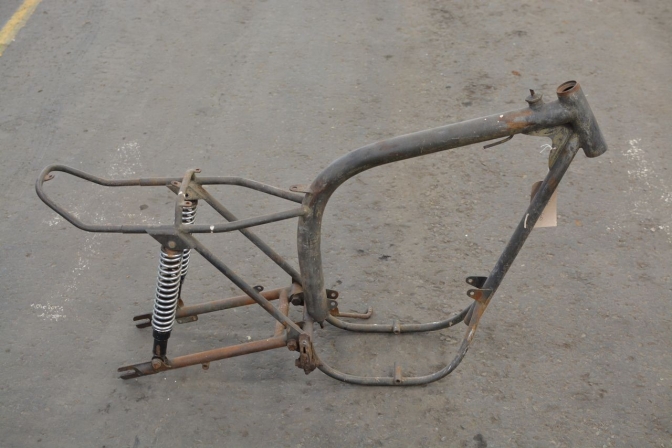
This "Firefly" frame sold by Brightwells, it is for a BSA C15 engine, but shows the frame build very well.
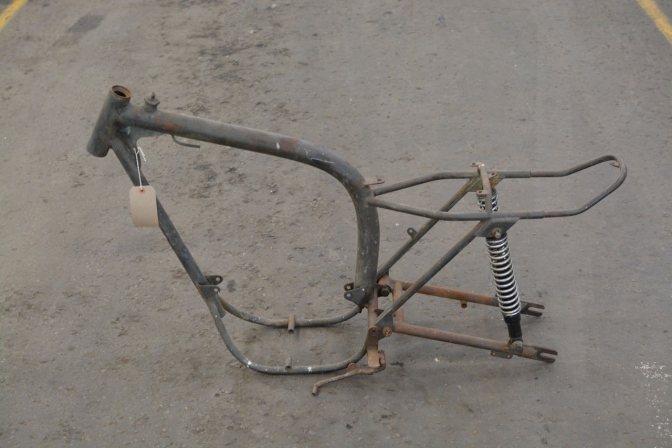
You can see that this frame is made to carry the oil in the frame too, 1969 vintage.
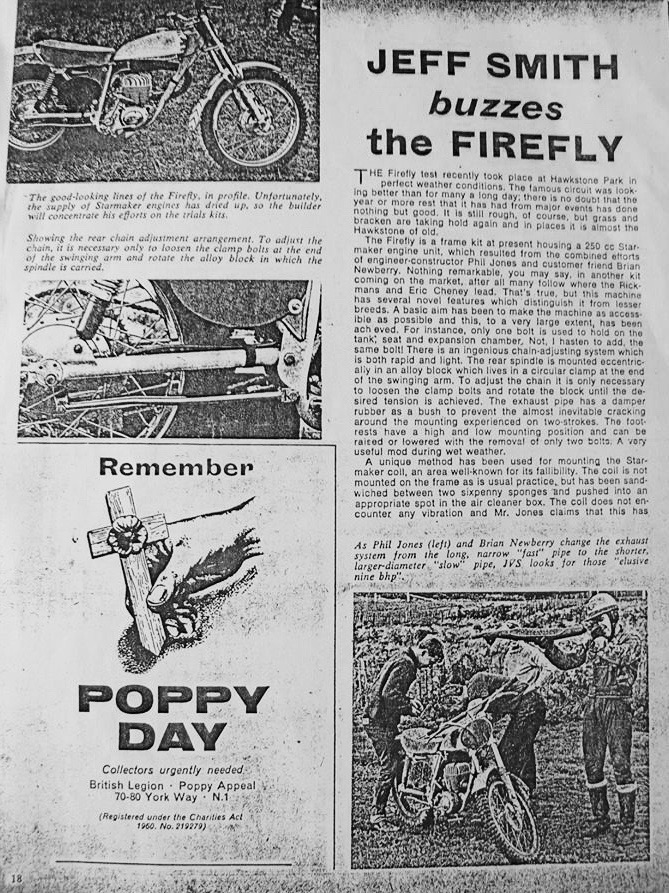
Material Courtesy John Lockwood.
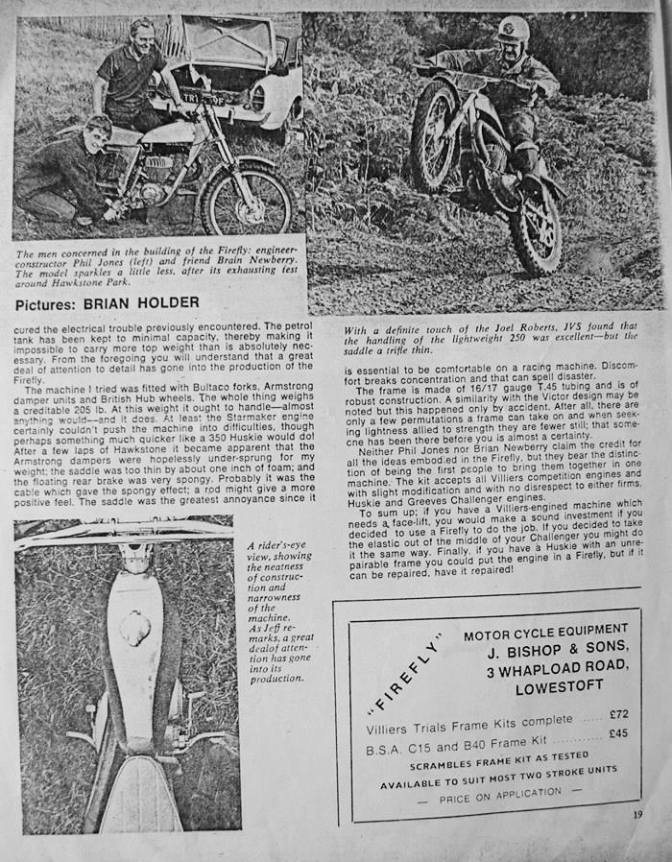
Material Courtesy John Lockwood.
~~~~~~~
DOT. Elstar, Butler, Norman, ETC have their own pages, and a page about the earlier Sun Wasp trials bikes later... 07/20/22
More information later. And even makes later... There were a lot of One-Off Villiers powered bikes at the time...
Kieft was one... there was one I.N. Johnson 197 Kieft in the 1960 Victory trial run by the Birmingham Motorcycle Club...
Updat2023...05...






